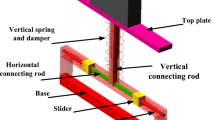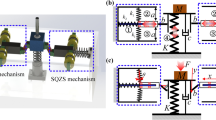Abstract
Recently, a mechanism for the High-Static-Low-Dynamic Stiffness (HSLDS) magnetic vibration isolator was introduced to overcome the fundamental limitation of a linear vibration isolator. The mechanism has a particularly useful property whereby the stiffness of the isolator is large enough to hold the weight of a load, but produces much softer stiffness when it responds to a dynamic motion. That is, the HSLDS magnetic vibration isolator shows highly nonlinear vibration isolation characteristic depending on the system parameters as well as the amplitude of base excitation. In this paper, the isolation performance of the HSLDS magnetic vibration isolator is examined both analytically and experimentally by considering both the key system parameter and the excitation amplitude of the base. The results show that the vibration isolation performance improves as the amplitude of base excitation increases. It was also found that the suggested key system parameter has an important role in the design of a practical system, and guarantees the minimum isolation performance regardless of the excitation amplitude.
Similar content being viewed by others
Abbreviations
- A :
-
excitation amplitude of the base
- L :
-
length between attracting magnets
- m :
-
mass
- c :
-
damping
- k :
-
stiffness
- x :
-
displacement of the mass
- u :
-
displacement of the base
- F m :
-
net magnetic force
- f m :
-
mass normalized net magnetic force
- ω :
-
excitation frequency
- ω n :
-
natural frequency of a linear system
- ω m :
-
equivalent natural frequency without linear springs
- ζ :
-
damping ratio
References
Gordon, C. G.. and Ungar, E. E., “Vibration Criteria for Microelectronics Manufacturing Equipment,” Proc. of Inter-Noise 83, pp. 490–495, 1983.
Kim, K. R., You, Y. H., and Ahn, H. J., “Optimal Design of a QZS Isolator using Flexures for a Wide Range of Payload,” Int. J. Precis. Eng. Manuf., Vol. 14, No. 6, pp. 911–917, 2013.
Puppin, E. and Fratello, V., “Vibration Isolation with Magnet Springs,” Review of Scientific Instruments, Vol. 73, No. 11, pp. 4034–4036, 2002.
D’Angola, A., Carbone, G., Mangialardi, L., and Serio, C., “Nonlinear Oscillations in a Passive Magnetic Suspension,” International Journal of Non-Linear Mechanics, Vol. 41, No. 9, pp. 1039–1049, 2006.
Bonisoli, E. and Vigliani, A., “Identification Techniques Applied to a Passive Elasto-Magnetic Suspension,” Mechanical Systems and Signal Processing, Vol. 21, No. 3, pp. 1479–1488, 2007.
Mizuno, T., Takasaki, M., Kishita, D., and Hirakawa, K., “Vibration Isolation System Combining Zero-Power Magnetic Suspension with Springs,” Control Engineering Practice, Vol. 15, No. 2, pp. 187–196, 2007.
Joshi, A., “Theoretical and Experimental Studies on Vibration Control in Cantilever Beams using DC Magnets,” Journal of Vibration and Control, Vol. 10, No. 7, pp. 995–1008, 2004.
Ibrahim, R. A., “Recent Advances in Nonlinear Passive Vibration Isolators,” Journal of Sound and Vibration, Vol. 314, No. 3–5, pp. 371–452, 2008.
Carrella, A., Brennan, M. J., Waters, T. P., and Shin, K., “On the Design of a High-Static-Low-Dynamic Stiffness Isolator using Linear Mechanical Springs and Magnets,” Journal of Sound and Vibration, Vol. 315, No. 3, pp. 712–720, 2008.
Robertson, W. S., Kidner, M. R. F., Cazzolato, B. S., and Zander, A. C., “Theoretical Design Parameters for a Quasi-Zero Stiffness Magnetic Spring for Vibration Isolation,” Journal of Sound and Vibration, Vol. 326, No. 1-2, pp. 88–103, 2009.
Zhou, N. and Liu, K., “A Tunable High-Static-Low-Dynamic Stiffness Vibration Isolator,” Journal of Sound and Vibration, Vol. 329, No. 9, pp. 1254–1273, 2010.
Shin, K., “Design Parameter Study on the Isolation Performance of the HSLDS Magnetic Vibration Isolator,” Transactions of the KSNVE, Vol. 20, No. 1, pp. 92–97, 2010.
Shin, K., “Experimental Evaluation of the Performance of the HSLDS Magnetic Vibration Isolator with Consideration of the Design Parameter,” Transactions of the KSNVE, Vol. 21, No. 4, pp. 352–356, 2011.
Carrella, A, “Passive Vibration Isolators with High-Static-Low-Dynamic-Stiffness,” Ph.D. Thesis, Institute of Sound and Vibration Research, University of Southampton, 2008.
Author information
Authors and Affiliations
Corresponding author
Rights and permissions
About this article
Cite this article
Shin, K. On the performance of a single degree-of-freedom high-static-low-dynamic stiffness magnetic vibration isolator. Int. J. Precis. Eng. Manuf. 15, 439–445 (2014). https://doi.org/10.1007/s12541-014-0355-4
Received:
Revised:
Accepted:
Published:
Issue Date:
DOI: https://doi.org/10.1007/s12541-014-0355-4




